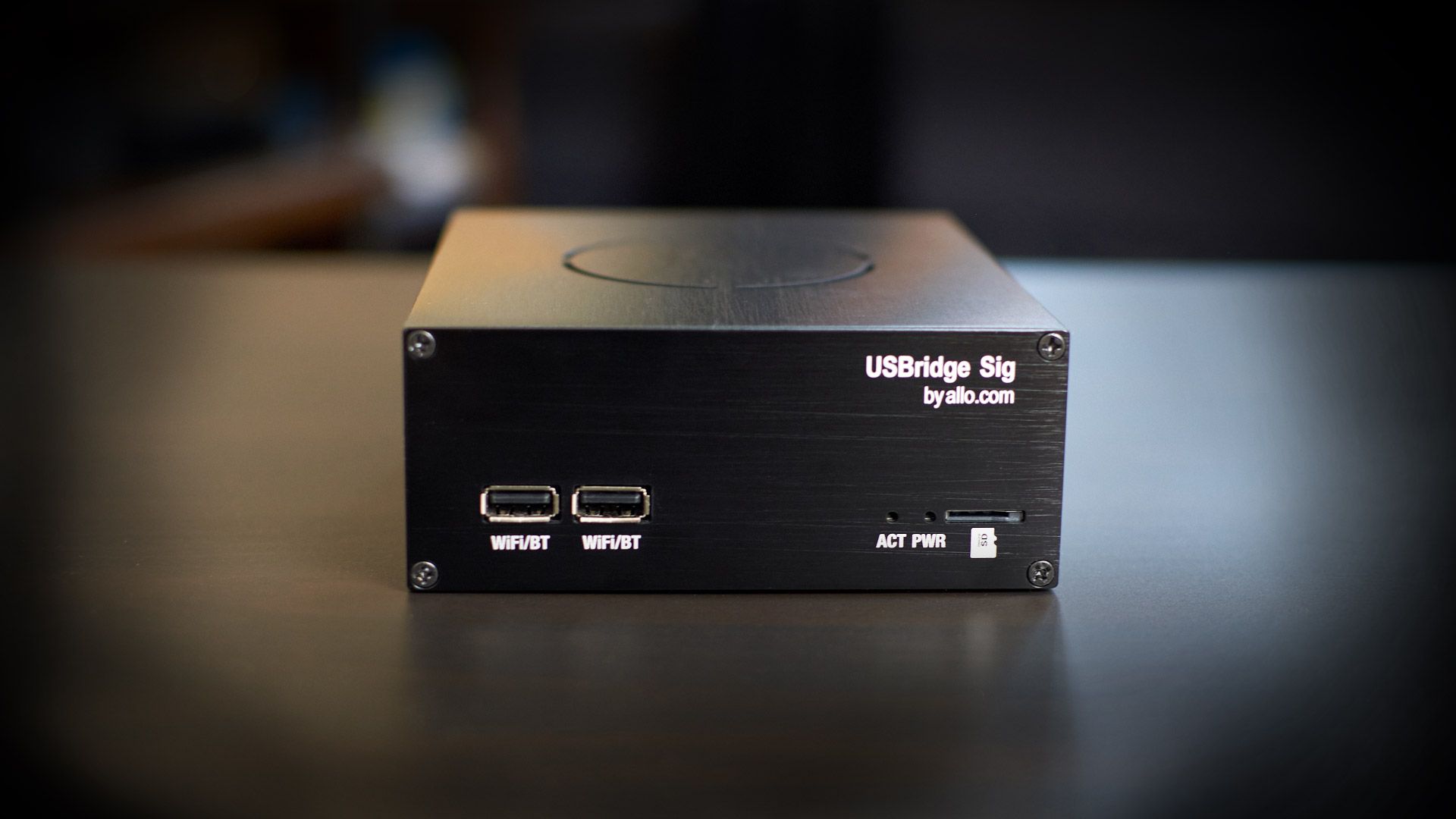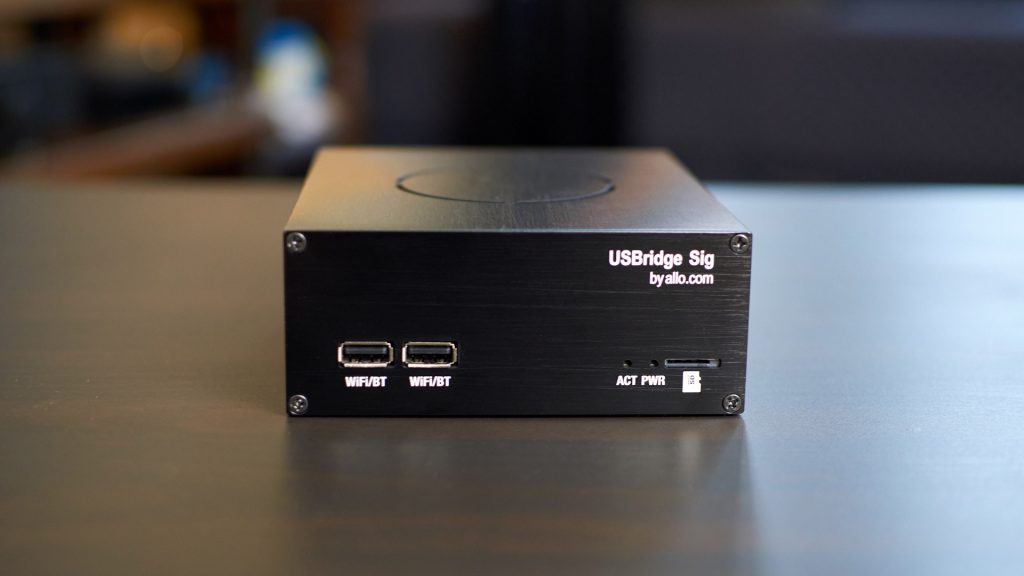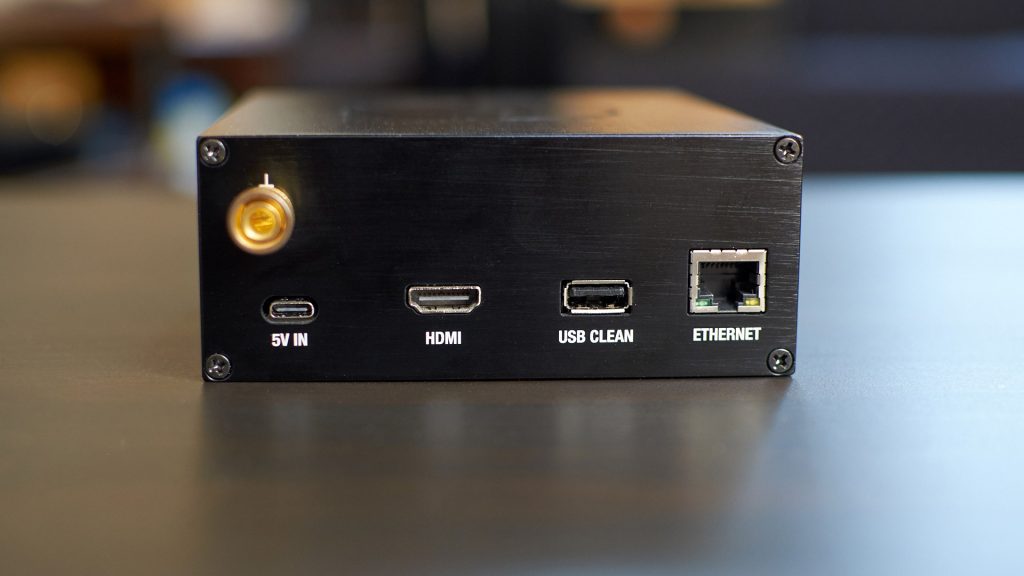USBridge Signature Player is an audio streamer made by Allo, a company that became known to the masses for its Raspberry Pi audiophile HATs. But unlike those HATs, USBridge Signature Player is a complete product, preassembled, boxed, and ready to be used without the user having to take a screwdriver even once. In today’s review, we’ll see how it works, how it sounds, and how it compares to Allo’s own DigiOne and DigiOne Signature.
Build and Connectivity
USBridge Signature Player uses an all-aluminum case. In the front, there are two USB input ports, two LED lights that tell users what’s going on with the unit, and a microSD port. The back panel hosts a USB-C power connector, HDMI port, Ethernet port, and “USB Clean” which is basically our USB output that will be connected to the DAC. Lastly, you’ll notice a golden binding post, the same one we find on speakers and amplifiers. In this case, it’s just a connector used to attach USBridge to an electrical ground, which should further improve its sound fidelity according to the manufacturer, but more on that a little bit later.
It is important to mention that microSD is used exclusively to boot the Operating System, and not to store any other files. More on that in the next section.
Features and Operating System
This section will be short and to the point. Aside from connectivity, all other features, including file support, streaming protocols supported (Roon, AirPlay, UPnP), streaming services supported (Spotify, Tidal, Qobuz, etc.) will depend on the Operating System you decide to load on the micro SD card and boot. You can basically choose any Raspberry Pi OS as USBridge Signature Player is based on the Raspberry Pi platform. Some of the most popular audio-dedicated operating systems are Volumio, Mood, RoPieeeXL, etc. This topic is wider than the scope of this review, so if you’re not familiar with any of these, you should probably do some research on each of these OS-es and find out which one suits you the most.
To make things just a bit more fun (euphemism for complicated), aside from different features, each OS will introduce a slightly different sound signature. Luckily, booting different ones and finding which one you preferred is easy enough, so let the explorer in you go wild and play with a few of them until you find your own favorite. Personally, I prefer RoPieeeXL, a very simple OS without an integrated music player, and it acts as a bridge only. Using mconnect or BubbleUPnP app on my Android phone, I’m able to browse Tidal and Qobuz and then cast the music stream to RoPieeeXL using UPnP protocol.
Sound
Out of the box, Allo USBridge Signature Player sounds cleaner and more detailed than any PC or laptop I’ve ever used. But for its full potential, a low noise power supply is needed. Just be aware that USBridge requires 5V/3A. I used Allo’s own Shanti linear power supply. Connected to it, the level of details improved noticeably and the soundstage deepened. Even more, if you use that binding post we mention earlier to ground USBridge to the Shanti, the sound will calm even further with a darker background and slightly juicier notes. At this moment, I felt USBridge Signature Player was sounding like a proper audiophile streamer that will not be out of place even in a very revealing HiFi system.
Compared to Raspberry Pi 4, which is the best Pi version when it comes to the sound quality over USB outputs, USBridge triumphs with relative ease, bringing more subtlety to the sound. Bass and midbass notes contain more texture, while the midrange is more transparent. Listening to the USBridge for some time and then returning to Pi 4 feels like midrange became denser but less informative. Some of the subtle information and air from the highest registers are also lost.
Next, I moved to more serious competition in form of Allo DigiOne and DigiOne Signature. I was fully expecting USBridge Signature Player to match the later one as they both contain “Signature” in their name, and are much closer in terms of pricing. Now, just before moving to the comparison, I know this is somewhat of comparing apples to oranges as every USB and SPDIF cable has its own sound signature. Different DACs also can sound better or worse over USB or SPDIF input. That said, there’s a power in numbers, and using several different cables and DACs helps clarify things more. So that’s exactly what I did. All of that said, I constantly felt that USBridge Signature Player was on pair with a basic DigiOne. They both appeared comparable in terms of bassline control and texture. The level of details in both midrange and highest parts of the spectrum was again very comparable. Moving to the Allo DigiOne Signature brought an increased insight into the tone texture, as well as more tiny details being dug from the recording. DigiOne signature also sounded more extended in the highest register, creating more air and retrieving more space and atmosphere around the instruments.
Conclusion
Allo USBridge Signature Player sounds really good. It’s a clear improvement over any PC, laptop, and Raspberry Pi 4. If the USB is your connection of choice, then I have no reason not to recommend it. That said, streamers based on SPDIF interface such as DigiOne and DigiOne Signature seem to offer more bang for the buck. Even the basic DigiOne is able to match the USBridge sonically with most of the DACs tested, while the DigiOne Signature takes the lead. So if you don’t have a strong reason for using USB, it’s definitely worth thinking about those two too.
Max2Play store offers everything R-Pi in one place (use code iiWiReviews2020 during purchase to get a 1-year free license to their audiophile Max2Play OS)
| ALLO USBRIDGE SIGNATURE PLAYER – CHARACTERISTICS |
|
3 x USB 2.0 Host: 1 on the rear side marked as USB CLEAN, 2 on the front side marked as Wi-Fi/BT |









You should have tested if the hat put inside the streamer sounds different than if put on the rasberry
hi Srboljub,
I want to ask, did you try to connect Intona USB to USBridge Signature?
Do you think this would have a positive effect on improving the sound?
I haven’t tried doing that since I didn’t have both of these at the same time. Sounds like an interesting but expensive idea. 🙂
hi, I’m responding with time lag and I can say that adding the Intona isolator to the Usbridge makes a big difference. I’m using a newer version of the isolator with an additional external power connector that takes it even further with a good power supply. Intona is really a very good gadget, I gradually replaced my AQ Carbon USB cables with Intona Reference, although they are quite expensive, but the difference was striking even compared to the relatively decent cables from Audioquest. I’ve been using Shanti for a long time, recently I changed to Ferrum Hypsos + 2x Ferrum splitter, with which I can simultaneously power up to 3 components: Allo usbridge Signature, Intona Isolator and Chord Qutest. I know it’s a long and winding road to better sound 😀 but my system responded very positively to every single change. I noticed that you are also adding written reviews to the page again, which makes me very happy, I like watching your reviews, they are really nutritious, keep it up, you are doing EXCELLENT 😎
I just upgraded from the DigiOne Sig and Shanti PWS to the USBridge Sig. With the DigiOne connected to the USBridge and all inc DAC grounded to the Shanti, yes the sound is definitely improved in many areas. Simply put I`m very happy with my purchase.